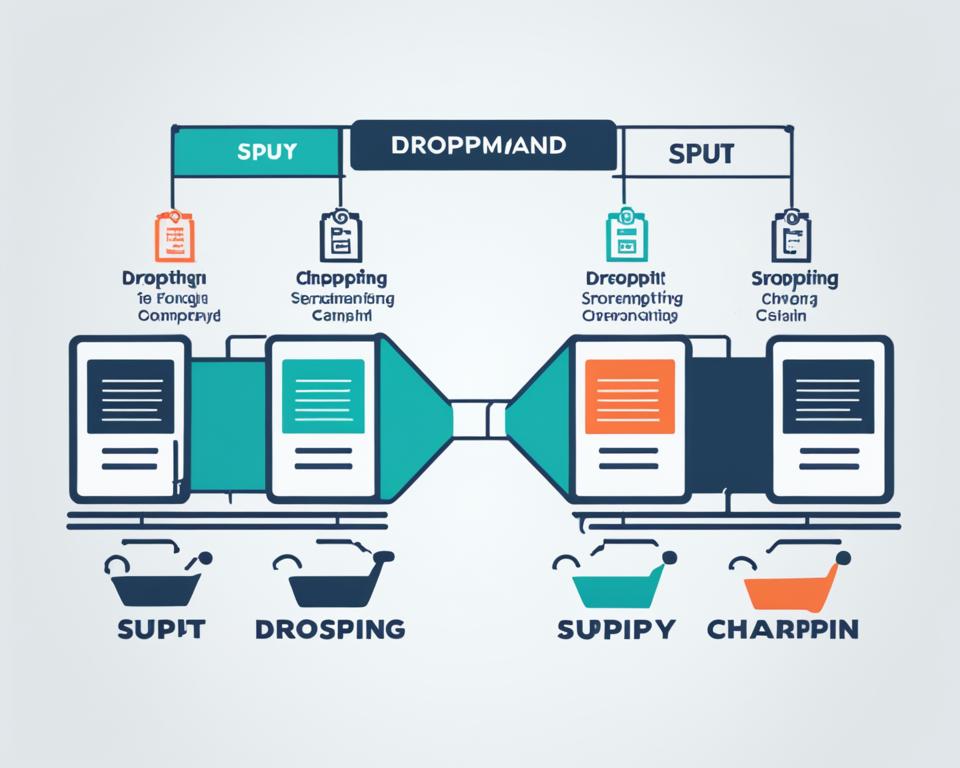In the world of online business, understanding the differences between print on demand and dropshipping is essential for enhancing our ecommerce strategies. Both methods involve selling products online, but there are distinct nuances that set them apart.
Table of Contents
ToggleKey Takeaways:
- Dropshipping: A business model where sellers don’t hold inventory, instead partnering with suppliers for storage, packaging, and shipping.
- Print on Demand: A business model where products are created and produced only when an order is placed, eliminating the need for inventory management.
- Pros and Cons: Dropshipping offers lower upfront costs but lower profit margins. Print on demand allows for customization but has reduced control over the production process.
- E-commerce Integration: Both dropshipping and print on demand can be integrated with popular e-commerce platforms like Shopify, WooCommerce, and Etsy.
- Considerations: Factors such as product nature, target market, customization level, and profit margins should be considered when choosing between dropshipping and print on demand.
What is Dropshipping?
Dropshipping is a popular and efficient business model for online entrepreneurs. With dropshipping, you can set up an online store and sell products without having to worry about inventory or shipping. Instead, you partner with dropshipping suppliers who handle all the logistics for you.
Here’s how dropshipping works:
- You set up an online store and list products from dropshipping suppliers.
- When a customer places an order on your store, you purchase the products from the dropshipping supplier.
- The supplier then packages and ships the products directly to the customer, so you never have to handle the inventory yourself.
Dropshipping offers several advantages for entrepreneurs looking to start an online business:
- No upfront investment: Since you don’t have to purchase inventory upfront, dropshipping is a low-cost business model that allows you to get started with little financial risk.
- Wide product selection: With dropshipping, you can offer a wide variety of products to your customers without having to maintain an inventory. You can work with multiple suppliers and choose from an extensive range of products to sell in your store.
- Flexible location: Dropshipping allows you to run your business from anywhere with an internet connection. As long as you can communicate with suppliers and customers easily, you can manage your business and fulfill orders from anywhere in the world.
Overall, dropshipping is a great option for entrepreneurs who want to start an online business without the hassle of managing inventory. By partnering with reliable dropshipping suppliers, you can focus on marketing and growing your store while leaving the logistics to the professionals.
What is Print on Demand?
Print on demand is a business model that allows sellers to create and produce products only when an order is placed. Instead of investing in and stocking inventory, sellers partner with print on demand services that handle the production and fulfillment process. This allows sellers to focus on designing or selecting products, such as t-shirts or mugs, while leaving the production and shipping to the print on demand service.
When a customer makes a purchase, the print on demand service prints the design on the chosen product and ships it directly to the customer. This eliminates the need for sellers to hold inventory, reducing upfront costs and the risk of unsold items. It also allows for greater flexibility in offering a wide range of products, as there is no need to invest in bulk quantities beforehand.
The print on demand model is especially popular among individuals and small businesses that want to enter the e-commerce market but may not have the resources or space to hold inventory. It enables them to test the market, experiment with different designs, and scale their business at their own pace.

Advantages of Print on Demand
- No Inventory Risk: With print on demand, sellers do not have to worry about excess inventory or unsold products.
- Minimal Upfront Costs: There is no need to invest in inventory upfront, reducing financial risks for sellers.
- Wide Product Range: The print on demand model allows sellers to offer a variety of products without having to hold physical stock.
The print on demand model provides a flexible and cost-effective solution for sellers who want to bring their unique designs and products to the online market.
Pros and Cons of Dropshipping
Dropshipping offers several advantages for online businesses. Some of the key benefits include:
- Low startup costs: Dropshipping allows entrepreneurs to start an online business without the need for significant upfront investment in inventory. This makes it an attractive option, especially for those with limited financial resources.
- No physical storage space required: With dropshipping, there’s no need to worry about storing and managing inventory. The products are stored and shipped directly by the suppliers, saving you the hassle and expense of maintaining a physical warehouse.
- Wide range of products: Dropshipping enables sellers to offer a wide variety of products to their customers. Since they are not limited by physical inventory, they can source products from multiple suppliers and cater to different customer preferences.
However, dropshipping also has its downsides. Some of the challenges associated with this business model include:
- Lower profit margins: As a dropshipper, your profit margins may be lower compared to traditional retail businesses. This is because you are essentially acting as a middleman and need to account for the supplier’s fees and additional costs involved in the fulfillment process.
- Reliance on suppliers: When you rely on dropshipping suppliers for fulfillment and shipping, you have less control over the customer experience. Any issues with inventory availability, shipping delays, or product quality will directly impact your business reputation.
- Inventory and quality control challenges: Since you don’t have direct control over the products, there’s a risk of running into inventory issues like overselling or stockouts. Additionally, ensuring consistent product quality can be challenging since you rely on suppliers to maintain high standards.
Pros and Cons of Print on Demand
When considering the use of print on demand services, it is important to weigh the advantages and disadvantages it offers. Understanding these pros and cons will enable us to make informed decisions that align with our business goals.
Pros of Print on Demand
- Minimal upfront costs: One of the major advantages of print on demand is the low initial investment required. With no need to hold inventory, we can avoid spending large sums on manufacturing or storage.
- No inventory management: Print on demand eliminates the need for inventory management, allowing us to focus our time and resources on marketing and expanding our product offerings.
- Customized products: This model empowers us to offer a wide variety of customized products, catering to the unique preferences and demands of our customers.
Cons of Print on Demand
- Reduced profit margins: Compared to traditional manufacturing, print on demand typically offers lower profit margins. This is due to the higher production costs associated with creating individual products one at a time.
- Reliance on print on demand services: As we rely on print on demand services for production and fulfillment, any disruptions or delays on their end may impact our ability to deliver products to customers in a timely manner.
- Limited control over printing process: With print on demand, we have limited control over the printing process, including the quality and speed of production. This may affect the overall customer experience and satisfaction.
Considering these pros and cons, it is crucial to evaluate whether print on demand aligns with our business objectives and requirements. While it offers flexibility, customization, and reduced upfront costs, it also poses challenges such as lower profit margins and limited control over production. By carefully weighing these factors, we can make well-informed decisions that set us up for success in the world of print on demand.
Integration with E-commerce Platforms
At Artisan Furniture Europe, we understand the importance of seamless integration between dropshipping and print on demand services with e-commerce platforms. This integration offers numerous benefits for online sellers, allowing them to efficiently manage their stores, streamline inventory and order management, and automate various processes.
Popular e-commerce platforms like Shopify, WooCommerce, and Etsy provide a range of plugins and extensions that facilitate easy integration with dropshipping suppliers and print on demand services. These integrations allow sellers to effortlessly connect their online stores with reliable suppliers and production services, ensuring a smooth and efficient workflow.
By integrating dropshipping platforms and print on demand services with e-commerce platforms, sellers can enjoy several advantages. They can easily manage inventory levels, update product information, and automatically synchronize changes across their e-commerce stores. This eliminates the need for manual inventory tracking and reduces the risk of overselling or underselling products.
In addition, e-commerce integrations enable sellers to automate order fulfillment processes. Once an order is placed, the e-commerce platform automatically notifies the dropshipping supplier or print on demand service, triggering the packaging and shipping process. This seamless automation minimizes errors, reduces processing times, and ensures timely delivery to customers.
Furthermore, by integrating with e-commerce platforms, sellers gain access to a wealth of analytics and reporting tools. These insights provide valuable data on customer behavior, sales trends, and performance metrics, enabling sellers to make informed business decisions and optimize their online stores for better conversions and profitability.
Whether you choose dropshipping or print on demand, integrating these services with e-commerce platforms is a crucial step towards building a successful online business. This integration not only simplifies operations but also enhances the overall customer experience, leading to increased customer satisfaction and repeat purchases.
Considerations for Choosing Between Dropshipping and Print on Demand
When deciding between dropshipping and print on demand, there are several factors to consider. These include the nature of your products, target market, desired level of customization, profit margins, and personal preferences. It’s important to evaluate the specific needs of your business and choose the model that best aligns with your goals and resources.
The Nature of Your Products
Consider the type of products you plan to sell. If you offer a wide variety of products that can be sourced from different suppliers, dropshipping may be a suitable option. On the other hand, if your business focuses on custom-designed or personalized products, print on demand may be a better fit.
Target Market
Understanding your target market is crucial when selecting a business model. If your audience values quick shipping times and a wide range of product options, dropshipping may be ideal. However, if your target market is interested in unique or personalized products, print on demand can provide the customization and exclusivity they desire.
Level of Customization
Consider the level of customization you want to offer. Print on demand allows for easy customization, as products can be personalized with unique designs or text. Dropshipping, on the other hand, may have limitations when it comes to customizing products that are pre-manufactured.
Profit Margins
Evaluate the potential profit margins associated with each model. Dropshipping generally has lower profit margins due to competitive pricing and the need to pay suppliers. Print on demand can offer higher profit margins as you have more control over pricing and production costs.
Personal Preferences
Lastly, consider your own preferences and strengths as a business owner. Some entrepreneurs may prefer the hands-on approach of managing inventory and working with suppliers in a dropshipping business. Others may appreciate the creative freedom and flexibility of designing and promoting custom products in a print on demand business.
By carefully considering these factors and conducting thorough research, you can make an informed decision about whether dropshipping or print on demand is the right model for your business. Remember, there is no one-size-fits-all solution, and it’s important to choose the approach that aligns with your unique business goals and circumstances.
Success Stories of Dropshipping and Print on Demand
When it comes to building successful online businesses, dropshipping and print on demand have proven to be lucrative models. Countless entrepreneurs have achieved remarkable success by leveraging the potential of these strategies. These success stories serve as a testament to the viability of dropshipping and print on demand in generating income and building brand recognition.
One inspiring example is Artisan Furniture Europe, an organization that has achieved great success through a dropshipping business model. By partnering with reliable suppliers and implementing efficient marketing strategies, Artisan Furniture Europe has been able to offer a wide range of high-quality furniture to their customers. This approach has allowed them to scale their business rapidly and establish a strong brand presence in the market.
Similarly, Love Prints is a notable success story in the print on demand industry. With an emphasis on personalized products, Love Prints offers a wide range of customized items, such as wall art and home decor. By collaborating with a print on demand service, Love Prints can fulfill orders seamlessly, ensuring customer satisfaction and repeat business. Their commitment to quality and unique design has garnered them a loyal customer base and significant financial success.
By researching and learning from these success stories, aspiring entrepreneurs can gain valuable insights and inspiration for their own ventures. Whether it is the efficiency of dropshipping or the creative potential of print on demand, these success stories highlight the pathways to success in the e-commerce industry.
Remember, success in dropshipping and print on demand is not limited to these stories alone. There are numerous entrepreneurs who have achieved remarkable results by harnessing the power of these business models. By understanding the possibilities and tailoring strategies to their specific niches, aspiring entrepreneurs can embark on a journey towards creating their own success stories.

Continuing to the next section, we will explore key tips for running a successful dropshipping or print on demand business, delving into the essential factors that can make a substantial impact on your entrepreneurial journey.
Tips for Running a Successful Dropshipping or Print on Demand Business
Running a successful dropshipping or print on demand business requires careful planning and execution. Here are some tips to help you navigate the competitive e-commerce landscape and maximize your chances of success:
- Find reliable suppliers or print on demand services: In order to maintain a steady supply of products and ensure timely delivery to your customers, it’s crucial to partner with trustworthy suppliers or print on demand services. Conduct thorough research and read reviews before making any commitments.
- Conduct market research: Understanding your target audience and their preferences is vital for offering products that meet their needs. Conduct market research to identify trending products, competitive pricing, and effective marketing strategies.
- Optimize product listings for search engines: Implementing search engine optimization (SEO) techniques will help improve the visibility of your products in search engine results. Use relevant keywords, compelling product descriptions, and high-quality images to attract organic traffic.
- Provide excellent customer service: Building trust and loyalty with your customers is paramount. Offer exceptional customer service by promptly responding to inquiries, resolving issues, and ensuring a smooth buying experience. Happy customers are more likely to recommend your business and make repeat purchases.
- Continuously test and improve your marketing strategies: Experiment with different marketing channels, such as social media advertising, influencer partnerships, or email campaigns. Analyze the results and make data-driven decisions to optimize your marketing efforts and maximize your return on investment.
By following these tips and staying adaptable, you can increase your chances of running a successful dropshipping or print on demand business. Remember, success in e-commerce requires continuous learning, adaptation, and a commitment to providing value to your customers.
Conclusion
The decision between dropshipping and print on demand hinges on the unique needs and goals of each individual business. By understanding the differences and considering key factors, entrepreneurs can make informed decisions and leverage these models to create successful online businesses.
Dropshipping offers the advantage of low startup costs, a wide range of products without inventory risk, and the elimination of the need for physical storage space. However, it does come with downsides such as lower profit margins and dependence on suppliers for fulfillment and shipping.
On the other hand, print on demand provides minimal upfront costs, the ability to offer customized products, and the elimination of inventory management. Nevertheless, it also has drawbacks like reduced profit margins compared to traditional manufacturing and reliance on print on demand services for production and fulfillment.
Ultimately, whether you choose dropshipping, print on demand, or a combination of both, there are ample opportunities for growth and success in the online business world. By carefully considering your business needs and goals, you can determine which model aligns best with your resources and pave the way for a thriving online venture.


